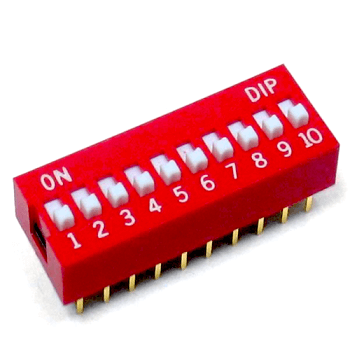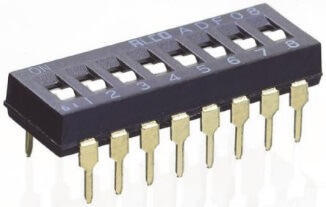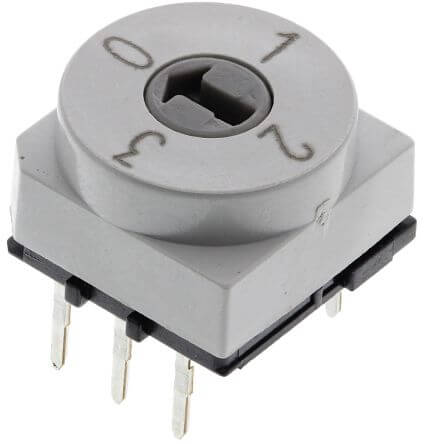What is a DIP Switch?
A DIP (Dual In-Line Package) switch is a small switch in a DIP that is packaged with others in a group to hold configurations and select the interrupt request. It is a set of manual electrical switches, which may refer to the unit as a whole, or to each individual switch, and its position changes the operating mode of a device. DIP switches are used in place of jumper blocks as well as help configure computer peripherals like motherboards, hard drives, sound cards, and modems.
The primary function of a DIP switch is to customize the behavior of an electronic device. In modern times, most computers use plug-and-play, which is the reason for the DIP switches are less common. Due to the use plug and play by computer, now the manual configuration is not needed by hardware. Normally auxiliary cards or expansion cards and motherboards include DIP switches.

The tiny rectangular components are involved in DIP switches, having a connecting mechanism and parallel rows of terminals to the circuit board. The need for DIP switches has decreased due to extra self-configuration hardware and programmable chips on a computer. Through a software control panel, settings can be accessed that make capable users to convenient changes easily.
Although they have multiple types, two are most common:
1. Slide and Rocker Actuator DIP Switches: With SPST contacts, these are on/off switches. The SPST stands for single-pole, single-throw. The one-bit binary value is contained by this type of DIP switch with a standard ASCII character.
Additionally, in various pole and throw configurations, DIP switches can also be found; including:
Single pole single throw (SPST): A type of switch where a single terminal to/from another one is connected or disconnected through a single toggle. It is considered the simplest type of switch.
Single pole double throw (SPDT): There are two terminals, one of two terminals are selected by the operator forced by switch; there is the conditions like two terminals will never be connected with each-other, and the switch will always be connected to one or the other.
Double pole double throw (DPDT): Its function is to two separate SPDT switches.

2. Rotary DIP Switch: The various electrical contacts are contained by this DIP switch that can be rotated and aligned. The switch can offer a selection of switching combinations and can be small or large in size.

The scenarios like where ease of adjustment for the user is considered paramount or where space on the PBC is especially limited, rotary DIP switches are often seen as particularly handy options. They are widely used in radio transmitters and receivers, test equipment, precision measurement gauges, aerospace, measurement gauges, military voice/data communications, sound mixing and editing, and precision. There were also some DIP switches that were not more popular; they are as follows:
- Multiple-throw, single-pole (MTSP)
- Double pole double throw (DPDT)
- Multiple-pole, single-throw (MPST)
- Double pole single throw (SPDT)
- Double pole single throw (DPST)
How do DIP Switches work?
In a small box or housing, a DIP switch is a small switch whose function is to offer a range of electrical inputs to an electronic device within the line or circle. It is also referred to a set of electrical switches, organized in a line or circle.
Applications of DIP switches
In the ISA architecture of PC expansion cards, they were commonly used to select IRQs (interrupt requests) and memory addresses. In the 1980s and early 1990s, before adverting cheaper, the use of DIP switches was common on arcade games to enter the game settings.
The common applications of DIP switches were garage door openers, including some early cordless phones. They were widely used with these applications to set security codes. The rolling code system is used in current garage door openers for better security. Older computers were not able to compatible with other video standards. On early video cards, these kinds of switches played a vital role in terms of facilitating compatibility with other video standards. For instance, For MDA, CGA cards offered compatibility.
DIP switches are not more common for consumers electronics, even they become less usable switches after the late 1990s. The reasons to become the DIP switches less common are decreasing cos of non-volatile memory, the trend toward smaller products, and through software menus. However, DIP switches are easy to incorporate into circuit designs and also not more costly, which makes them more common in use in industrial equipment. In some remote controls, DIP switches are still used to prevent interference. Some key points of uses of DIP switches are given below:
- DIP switches comprise expansion modules, modems, video cards, motherboards, hard drives, and more.
- Arcade Game Machines
- On garage door openers mechanisms, they are still commonly used.
- PC Expansion Cards
- Remote Controls
History of DIP switch
The earliest DIP switch patent was the US patent 3,621,157. Pierre P. Schwab invented a rotary style DIP switch that is disclosed by this patent. On June 1, 1970, Schwab’s patent application was filed, and on November 16, 1971, the patent was granted.
In 1976, the DIP switch was granted US patent 4012608. In 1974, it was applied, and in 1977, it was used in an ATARI Flipper game.
Pros & Cons of DIP switches
Without losing the parts, the ability to quickly change positions are the main advantages of DIP switches. They are another option for jumper blocks. But recently due to the increase of easily customizable software configurations, the acceptance of DIP switches has decreased.
However, in industrial equipment and other various functions, they are widely in use. It offers a benefit that they are easy to incorporate into circuit designs without the system being turned on that makes it easy to design a circuit without the need checking their configurations.
Where are DIP switches found on the device?
Mainly, DIP switches are found on the latest devices, not on all devices. Suppose your device has anything that resembles the above picture of DIP switches. Check out jumpers rather than DIP switches.
